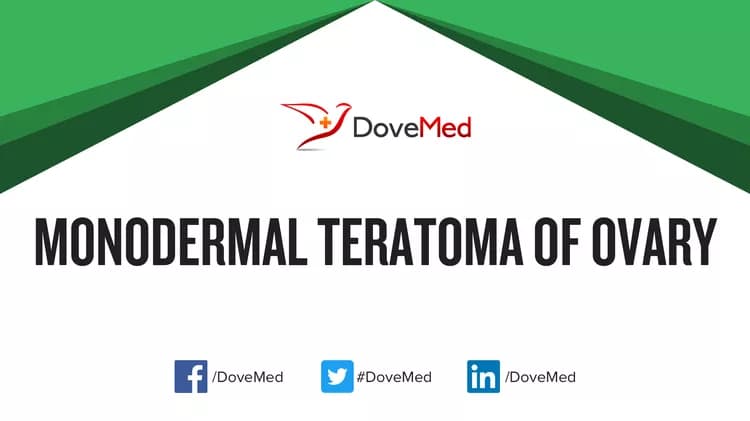What are the other Names for this Condition? (Also known as/Symptoms)
- Ovarian Monodermal Teratoma
- Specialized Teratoma of Ovary
What is Monodermal Teratoma of Ovary? (Definition/Background Information)
- Teratoma of ovary is a rare type of ovarian tumor that arises from the germ cells. It is usually observed in adolescent and young women
- Monodermal Teratoma of Ovary is an uncommon form of teratoma that originates from a single germ cell layer, composed only of a single tissue type (such as thyroid tissue or nerve tissue), on examination of the tumor sample by a pathologist under the microscope. The tumor may be cystic or solid in nature
- The following 3 main types of Ovarian Monodermal Teratomas are described:
- Struma ovarii, which is composed of mature thyroidal tissue
- Carcinoid tumor; uncommon tumors composed of neuroectodermal tissue seen in women after menopause
- Neural tumor; uncommon tumors showing neural differentiation
- The cause of formation of Monodermal Teratoma of Ovary is unknown. Also, presently, the risk factors for the same are not well-established. These tumors are mostly benign, but infrequently may turn malignant
- In many cases, no signs and symptoms of teratoma are observed and these tumors are diagnosed incidentally. Some tumors may grow to large sizes and cause obstructive signs and symptoms. Also, malignant ovarian teratomas may metastasize to distant organs
- The treatment of Monodermal Teratoma of Ovary involves surgery in most cases. Malignant teratomas may be additionally treated using chemotherapy and/or radiation therapy
- In most of the cases, the prognosis of a benign teratoma is excellent with early appropriate treatment. However, the prognosis of a malignant Ovarian Monodermal Teratoma depends upon numerous factors and can be only assessed on a case-by-case basis
Who gets Monodermal Teratoma of Ovary? (Age and Sex Distribution)
- Monodermal Teratoma of Ovary is a rare type of teratoma that may be observed in girls and women, including postmenopausal women
- No specific racial or ethnic group predilection is noted
What are the Risk Factors for Monodermal Teratoma of Ovary? (Predisposing Factors)
- Currently, no definite risk factors have been identified for Ovarian Monodermal Teratomas
It is important to note that having a risk factor does not mean that one will get the condition. A risk factor increases one’s chances of getting a condition compared to an individual without the risk factors. Some risk factors are more important than others.
Also, not having a risk factor does not mean that an individual will not get the condition. It is always important to discuss the effect of risk factors with your healthcare provider.
What are the Causes of Monodermal Teratoma of Ovary? (Etiology)
The cause of development of Monodermal Teratoma of Ovary is generally unknown. It is believed that abnormal differentiation of germ cells gives rise to the formation of this tumor.
- In general, it is known that cancers form when normal, healthy cells begin transforming into abnormal cells - these cancer cells grow and divide uncontrollably (and lose their ability to die), resulting in the formation of a mass or a tumor
- The transformation of normally healthy cells into cancerous cells may be the result of genetic mutations. Mutations allow the cancer cells to grow and multiply uncontrollably to form new cancer cells
- These tumors can invade nearby tissues and adjoining body organs, and even metastasize and spread to other regions of the body
What are the Signs and Symptoms of Monodermal Teratoma of Ovary?
The signs and symptoms of Monodermal Teratoma of Ovary depend on the subtype of the tumor. It may vary from one individual to another. In general, most (small) tumors are asymptomatic and no significant symptoms are observed, while large tumors are known to present symptoms.
The signs and symptoms of Monodermal Teratoma of Ovary include the following:
- Presence of a well-circumscribed tumor in the ovary; monodermal teratomas are generally benign
- The tumors may be solid or cystic (fluid-filled) in nature
- Generally, only one ovary is affected; but, involvement of both ovaries may be seen (bilateral teratoma)
- The tumors may range in size from a few cm to over 25 cm
- Large tumors (size over 4 cm) can compress the surrounding structures or organs and give the sensation of an abdominal mass
- Abdominal pain from large-sized ovarian tumors
- Abdominal discomfort, heaviness, and tenderness (especially at the iliac fossa, which is an area near to the hip bone)
- Pelvic discomfort and pain; lower back pain
- Frequent urination due to compression/pressure of the tumor
- When metastasis is noted, it may result in weight loss, fatigue, and other systemic symptoms
How is Monodermal Teratoma of Ovary Diagnosed?
There are a variety of tests the healthcare provider may employ to diagnose Monodermal Teratoma of Ovary, which may include:
- Physical examination and complete medical history screening
- Assessment of the symptoms observed
- Blood tests for various markers
- Alpha fetoprotein (AFP) blood test
- Ultrasound scan of the pelvis: It is a non-invasive procedure that uses high frequency sound waves to produce real-time images
- Transvaginal ultrasound: An ultrasound is inserted into the vagina and the mass is examined using sound waves
- Abdominal and pelvic CT scan: It is a non-invasive procedure that provides more details of soft tissues, blood vessels, and internal organs
- Pelvic MRI scan: It is a non-invasive medical test that uses a powerful magnetic field to produce images of soft tissues, bones, organs, and all other internal structures of the abdomen and pelvis
- Hysteroscopy: This procedure involves placing a probe through the cervix to examine the cavity of the uterus
Invasive diagnostic procedures such as:
- Laparoscopy: A special device is inserted through a small hole into the abdomen, to visually examine it. If necessary, a tissue sample is obtained for further analysis. Exploration of the abdomen using a laparoscope is called ‘exploratory laparoscopy’
- Laparotomy: The abdomen is opened through an incision for examination, and if required, a biopsy sample obtained. Exploration of the abdomen using laparotomy procedure is called ‘exploratory laparotomy’
Although the above modalities can be used to make an initial diagnosis, a tissue biopsy of the tumor is necessary to make a definitive diagnosis to begin treatment. The tissue for diagnosis can be procured in multiple different ways which include:
- Fine needle aspiration (FNA) biopsy of the tumor: A FNA biopsy may not be helpful, because one may not be able to visualize the different morphological areas of the tumor. Hence, a FNA biopsy as a diagnostic tool has certain limitations, and an open surgical biopsy is preferred
- Core biopsy of the tumor
- Open biopsy of the tumor
Tissue biopsy:
- A tissue biopsy of the tumor is performed and sent to a laboratory for a pathological examination. A pathologist examines the biopsy under a microscope. After putting together clinical findings, special studies on tissues (if needed) and with microscope findings, the pathologist arrives at a definitive diagnosis. Examination of the biopsy under a microscope by a pathologist is considered to be gold standard in arriving at a conclusive diagnosis
- Biopsy specimens are studied initially using Hematoxylin and Eosin staining. The pathologist then decides on additional studies depending on the clinical situation
- The tumors may have varying proportions of blood vessels, smooth muscle, and fat cells, when examined by a pathologist under a microscope
- Sometimes, the pathologist may perform special studies, which may include immunohistochemical stains, molecular testing, and very rarely, electron microscopic studies to assist in the diagnosis
Note: A majority of Ovarian Monodermal Teratoma tumors are discovered incidentally.
Many clinical conditions may have similar signs and symptoms. Your healthcare provider may perform additional tests to rule out other clinical conditions to arrive at a definitive diagnosis.
What are the possible Complications of Monodermal Teratoma of Ovary?
The complications of Monodermal Teratoma of Ovary may depend on the subtype of the tumor, whether benign or malignant, and may include the following:
- Stress and anxiety due to fear of cancer of the ovary
- Large tumor masses may get secondarily infected with bacteria or fungus
- Tumor rupture and torsion:
- Rupture of tumor can cause peritonitis
- Usually, larger tumors are more prone for torsion
- Ovarian torsion can result in acute abdominal pain and a surgical emergency
- Some teratomas are known to transform to malignancies
- Metastasis of malignant teratoma to distant sites
- Recurrence of the tumor following its incomplete surgical removal
- Malignant teratomas are most commonly squamous cell carcinomas, sarcomas, or adenocarcinomas
There may be complications related to the methods used in treating the condition and may include:
- Side effects of radiation therapy that may include sunburn-like rashes, where radiation was targeted, red or dry skin, heaviness of the breasts, and general fatigue
- Side effects of chemotherapy, which may include nausea, vomiting, hair loss, decreased appetite, mouth sores, fatigue, low blood cell counts, and a higher chance of developing infections
- The treatment can also cause infertility in men and women. Hence, measures to protect the individual’s fertility must be considered, before starting chemotherapy
- Damage to the muscles, vital nerves, and blood vessels, during surgery
- Post-surgical infection at the wound site is a potential complication
How is Monodermal Teratoma of Ovary Treated?
The treatment of Monodermal Teratoma of Ovary may involve the following:
- Generally, the treatment of choice is complete surgical excision for all teratomas. The following surgical procedures may be considered:
- Operative laparoscopy
- Cystectomy or surgical removal of the ovarian cyst
- Oophorectomy or removal of the affected ovary
- Ovarian tissue sparing techniques
- Additionally, chemotherapy and/or radiation therapy may be necessary for malignant teratomas
- Follow-up care with regular screening and check-ups are important and encouraged
How can Monodermal Teratoma of Ovary be Prevented?
Currently, there are no known methods to prevent the development of Monodermal Teratoma of Ovary.
What is the Prognosis of Monodermal Teratoma of Ovary? (Outcomes/Resolutions)
The prognosis of Ovarian Monodermal Teratoma depends upon the subtype of the tumor and whether the tumor is benign or malignant.
- Tumors that behave in a benign manner, with complete surgical removal of the tumor, can have an excellent prognosis
- Malignant teratomas may be aggressive, difficult to treat (complete tumor resection may not be possible), and can spread to other sites. The prognosis of these tumors is usually assessed on a case-by-case basis
Additional and Relevant Useful Information for Monodermal Teratoma of Ovary:
The following article link will help you understand other cancers and benign tumors:
Related Articles
Test Your Knowledge
Asked by users
Related Centers
Related Specialties
Related Physicians
Related Procedures
Related Resources
Join DoveHubs
and connect with fellow professionals


0 Comments
Please log in to post a comment.